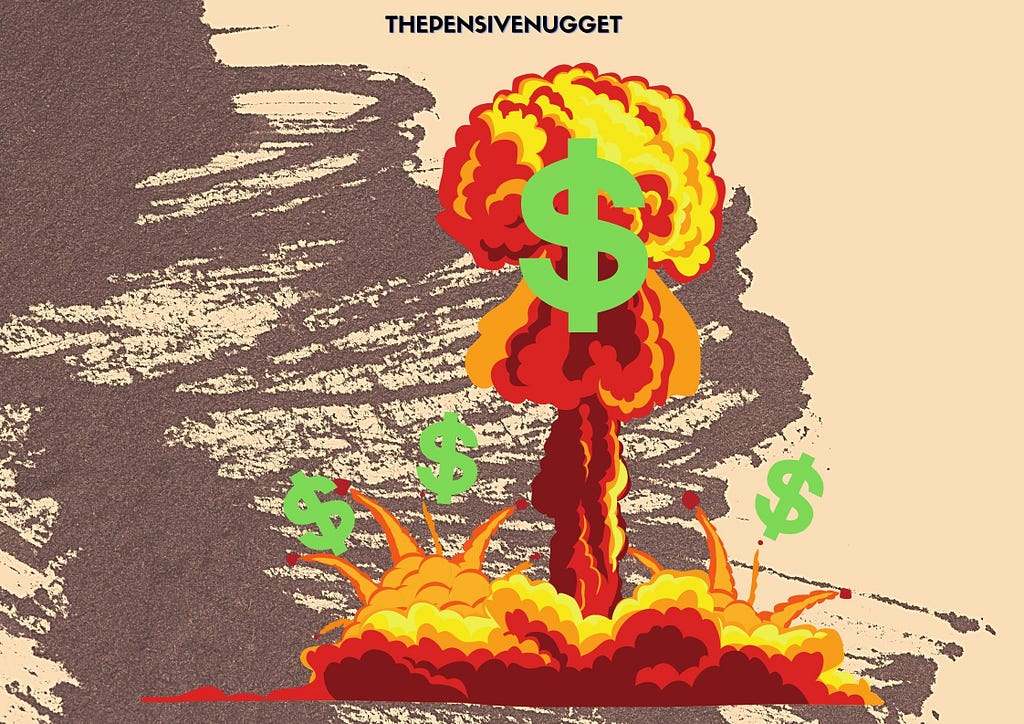Originally posted on thepensivenugget.com
The recent failure of Silicon Valley Bank (SVB) has driven markets into a frenzy of trying to understand why it happened, and what broader systemic implications it may have.
The US government has stepped in to backstop depositors in an attempt to prevent further bank runs, but mainstream narratives continue to miss a broader point — bank runs are symptoms of a much more troublesome problem.
One large enough to potentially trouble the entire global financial system.
The Repo Lurking Behind The Narrative
Popular narratives that have been used to explain SVB’s blowup run along similar lines:
- Banks took in cheap deposits when rates were low and couldn’t lend all of it out, which led them to invest in other fixed income securities, like US Treasuries (USTs) and Mortgage Backed Securities (MBS) instead. With the Fed and other major global central banks’ recent campaign of aggressive rate hikes, this narrative concludes that falling prices from rising rates caused, and will cause, banks to take major losses.
- Or, with a subtle difference, banks took in cheap deposits and invested them in longer term fixed income securities. This mismatch of borrowing and lending durations caused them to be unable to fulfill depositors’ rush to withdraw their money.
The issue with the first narrative is that it is quite misleading. Banks do not “lend out deposits” in quite so direct a manner as is implied by the narrative. Bank loans are made by simple ledger entry, with a bank creating an asset on its balance sheet (the loan), offset with a liability (the amount of the loan in the loanee’s account).
As such, bank loans are not a simple matter of taking $1000 of deposits from one depositor and lending that same $1000 out to a loanee.
Briefly, when a depositor receives money in their bank account, for example as a salary payment, bank reserves are transferred from the employer’s bank account to the depositor’s. Bank reserves are what banks use to settle interbank transfers initiated by its customers, and are shuttled between banks via the Fed’s Fedwire system on a net basis at the end of each day.
What this means is that a bank needs to have adequate bank reserves to cover any net outward transfers at the end of each business day. Of course, if more people are transferring funds into the bank than out of it on that day, it does not need to worry about bank reserves (at least for that particular day).
SVB getting a huge influx of deposits just means that it received a lot of bank reserves, which are not actually lent out — as explained a few paragraphs above. Consequently, the influx of bank reserves into SVB due to the tech boom did not create a situation where SVB could not lend them all out, as they aren’t lent out in the first place. (If you want to get a better understanding of these concepts, you can learn more about bank reserves here and how money is really created here)
Instead, SVB’s ability to create more loans would be determined by how stringent their loan officers were in screening new clients, as well as demand for loans by the bank’s customer base; not by how much deposits SVB received.
However, the influx of deposits did still mean that SVB was faced with a choice of how to invest them in order to get a decent return. They did so by purchasing safe fixed income assets, which brings us to the next point — banks do not need to take losses on their fixed income investments if they are classified as held-to-maturity securities.
That is, if a bank’s intention is to hold USTs as an income generating investment, and not simply to buy and sell them for a quick profit or market making purposes, they do not have to mark their investments to current market prices.
This runs contrary to the simple relationship that current mainstream narratives seem to imply, that losses from SVB’s fixed income investments were the main factor in toppling the bank. Moreover, it also completely misses out on a very important point. That is, US Treasuries can be used as collateral to raise capital quickly in the repo market, as USTs are the best source of collateral used in repo.
Which begs the question, why didn’t SVB tap the repo market?
Two broad scenarios are plausible here. The first being that SVB chose not to do so. In SVB’s 1Q23 mid quarter update, dated 8 March, SVB stated that it sold $21 billion in fixed rate available-for-sale securities (page 9 of the PDF linked above), which are securities that are not held-to-maturity, and also not purchased for trading purposes.
This was done with the intent to rebuild its portfolio with shorter duration fixed rate USTs.
In other words, SVB ostensibly didn’t sell their portfolio to raise capital to fund customer withdrawals, but to attempt to benefit from what the bank thought was going to be a sustainably higher interest rate environment. If this were entirely true, SVB’s management had their plan completely backfire, as the proceeds raised from the sale of their securities obviously wasn’t enough to cover withdrawals.
The second plausible reason for SVB not tapping the repo market is that it simply could not do so. That, even with its large holding of USTs, the bank failed to raise money in the repo market; to the extent that it had to sell its securities to raise capital.
Note that most financial institutions prefer to pledge USTs as collateral to borrow in the repo market first, as repo borrowing can be easily rolled over most of the time. Outright selling tends to be a last resort, which implies that it wasn’t just depositors who lost confidence in SVB, the repo market did too. This could have meant that SVB faced repo borrowing costs (haircuts) that were so high as to completely discourage them from transacting, and/or counterparties in the repo market simply refused to do business with them.
Moving on to the second narrative, which pinpoints the mismatch in SVB’s assets and liabilities as the main cause in the bank’s failure; in other words, borrowing in short term markets to fund longer term investments. This isn’t inaccurate per se, and actually highlights one of the biggest problems that all banks face, which is their business models naturally push them to mismatch the duration of their assets and liabilities.
Consider that all banks operate on the same basis of taking in deposits and lending on a longer term to businesses, consumers, and governments (by buying government bonds).
Deposits are “short term” because they can be withdrawn by depositors at any time, while loan payment periods can stretch out over decades. There isn’t a bank on earth that takes in deposits and only makes overnight loans, simply because it would struggle to make any kind of decent profit.
However, not all banks fail. As a matter of fact, on a percentage basis, much more banks survive (or get bought up/merged) than fail. The evidence for this lies in the fact that the modern banking and credit creation systems have existed for a few centuries.
Consequently, the model of borrowing short term to fund longer term assets, while dangerous in its own right, not to mention awfully short convexity, is only part of the SVB problem.
As discussed above, SVB clearly could not access any kind of short term funding market in the run up to its failure. But, this does not mean that the sole cause of the problem lies in their mismatch of assets and liabilities. The other part, is, once again, the loss of the bank’s ability to fund itself in short term borrowing markets.
Financial history is littered with spectacular failures of firms, both financial and otherwise, who blew themselves up when they could no longer access short term borrowing to meet the funding needs of their long term investments.
Repo, The Root Of Systemic Problems
At this point, it is quite clear that the repo market is the unseen, and untalked about, common factor lying in the shadows of both narratives. Which brings us to a curious observation, that SVB’s failure has occurred during a seasonal period of time where liquidity in the repo market tends to be low.
This tends to happen close to the end of each quarter, and coincides with some of the largest and most disruptive financial crises in recent history.
In 2008, Wall Street was grossly over-leveraged and overexposed to the US housing market, with Bear and Lehman falling victims to their inability to fund margin calls during quarter end repo liquidity tightness. Bear collapsed in March ’08 (late 1Q), and Lehman in September of the same year (late 3Q).
The same thing happened on a much larger scale in late Feb/early March of 2020, when global shutdowns due to the initial outbreak of COVID, coinciding with the nearing end of the 1st quarter, wreaked havoc on financial markets all over the world.
The point here isn’t to simply blame seasonal drops in repo liquidity for bank/financial system failures. It is simply to state that the probability of such failures are markedly higher when confidence in banks takes a battering during periods of lower liquidity in repo.
Which brings us to the potentially trillion dollar question. Is SVB’s failure a harbinger of things to come from a global, systemic perspective?
Due to the narratives mentioned above, which place the blame squarely on banks holding large amounts of Treasuries (and other fixed income instruments), many people are currently inclined to believe that banks all over the world are in trouble, since the value of their fixed income holdings have plummeted.
However, as also explained above, the real danger does not lie in the holdings’ themselves, but the inability of banks to fund their capital needs.
Here is a simple breakdown of what goes on:
1) Deposits are essentially unsecured loans that customers make to banks. This in effect makes depositors junior creditors. They are junior because in the capital structure, secured loans have seniority when it comes to being paid back first in the event of liquidation. Of course, with government intervention, as witnessed over the weekend, political necessities can upend the capital structure.
2) Banks don’t lend deposits out, instead, the cash is used to meet daily transfer requirements arising from the transactions of its customers, and also for a bank’s own business needs.
3) Should there be a large demand for customer withdrawals, i.e. a bank run, a bank needs to fund these withdrawals by borrowing cash. They can do so either via short term borrowing markets, like repo and the Fed Funds market, or in emergencies, from the Fed’s discount window (or other emergency Fed/government lending facility).
As such, holding unrealized losses on fixed income investments does not actually hinder a bank’s ability to meet withdrawals. If it did, many more banks, and not just in the US, would be facing bank runs at this point, given how much rates have risen over the last year, and how quickly.
Instead, as already mentioned multiple times above, but bears repeating again just because of how important it is — what matters is a bank’s continued access to short term borrowing markets. When this access is revoked, the bank will fail barring an intervention from the central bank and/or government.
This is not to say that huge losses on banks’ fixed income investments aren’t important. They are. Firstly, when a struggling bank is forced to sell its fixed income investments at a loss, it leaves them with less capital than they initially borrowed to pay back their creditors, which obviously is a recipe for disaster.
But what is of more importance here is the psychology of it. At the end of the day, our modern banking system and economy runs on confidence. When confidence evaporates, access to credit quickly dries up.
As such, SVB’s failure, embedded together with the growing momentum of the “large fixed income losses” narrative, is a very dangerous combination that could lead to further bank runs. Adding fuel to this fire is tighter liquidity conditions in the repo market, which now has to contend with not only its seasonal quarter end issues, but also the fear and uncertainty of other bank failures.
Systemic Risk Watch: Look Beyond Equities!
The temptation at this point will be to look at US equity markets for direction, as well as indications of future selloffs in global markets. After all, bank stocks have a giant crosshair drawn on them at this point, especially in smaller segments of the banking sector, and it intuitively makes sense to look at further selloffs here as indications of a broader crisis to come.
However, from a systemic perspective, lower repo liquidity means a general, across the board withdrawal of short term funding for all other financial markets. After all, when lenders pull back on providing credit, they tend to do so en masse, and indiscriminately.
Naturally, this leads to margin calls and sell offs, which have the potential to spark a vicious and nasty cycle of liquidations across the globe.
Consequently, focus needs to be on the largest macro markets instead, namely the USD and UST rates, as they will give a clearer and more reliable indication of the probability of a global risk off scenario. The reason for this is that repo and other short term funding markets are both global and highly interconnected in nature, not to mention much larger than US equity markets.
Therefore, while US equities can be driven by wild swings in bank stocks as equity investors and traders panic, the USD and UST markets take much more to move them in a meaningful way.
In addition, the USD is a reliable indicator of global crises due to it being the world’s reserve currency, and its close connection to the global repo market, where banks, corporations, and governments regularly post collateral to borrow USDs to meet their needs. In other words, problems in the repo market, when they get big enough, will show up in the global USD market, and hence USD FX rates.
While US equities might present decent trading opportunities in the short term, both on the long and short side, depending on how you might want to position yourself amidst current uncertainty, don’t lose sight of the bigger macro picture.
This is especially important as overall macro conditions have deteriorated from where they were a year ago (except for the US labor market), and global recession is now a real concern, as indicated by deeply inverted UST and Eurodollar curves.
In other words, any economic mishaps that occur now have the potential to cause more harm than if conditions were more benign. It is also worth noting that economic mishaps, such as bank runs, tend to occur much more often during periods where economies are sliding towards recession, simply because financial conditions are no longer as forgiving as they were during expansionary parts of the cycle.
As such, look past any large rallies in equity markets driven by hope and speculation of what the Fed, and/or the US government, is, or may be doing. Focus on the USD and US rates, and if you can, Eurodollar futures.
These are the markets that really matter when it comes to systemic risk, and which really tell you what to expect in the future.
Especially keep an eye out for change in trends, breakouts of key levels, and most of all, an alignment between markets. When multiple markets start to move in tandem, and in a direction which screams danger, the likelihood of a global selloff, if not a full blown systemic crisis, is at its highest.
At time of writing, government bond yields have fallen sharply, which mainstream narratives will portray as a flight-to-safety trade. While the desire for safer assets will be a part of why rates have fallen so quickly in just 2 days, lower rates also demonstrate a collateral crunch. Simply put, participants in repo and other short term borrowing markets are dashing to get as much collateral as possible to ensure that they have enough to meet potential margin calls should volatility and uncertainty persist.
Lastly, bear in mind that a sharp and broad global selloff in risk assets may not come immediately, and indications of one may not show up for a few more months. This is not a time to be complacent, as the rest of 2023 now looks increasingly dicey for markets, which are growing increasingly vulnerable to a large global selloff.
Remember that Bear Stearns failed in mid March 2008, but the Fed intervened and everyone thought that was the end of any further mishaps… until Lehman took down everything else just 6 months later.
Do you want to make money trading a crisis? Check out our course on how to do so. And don’t forget to sign up for our FREE course on how to create a trading plan!
Silicon Valley Bank: The Big Problem That You Need To Know was originally published in InsiderFinance Wire on Medium, where people are continuing the conversation by highlighting and responding to this story.



Comments